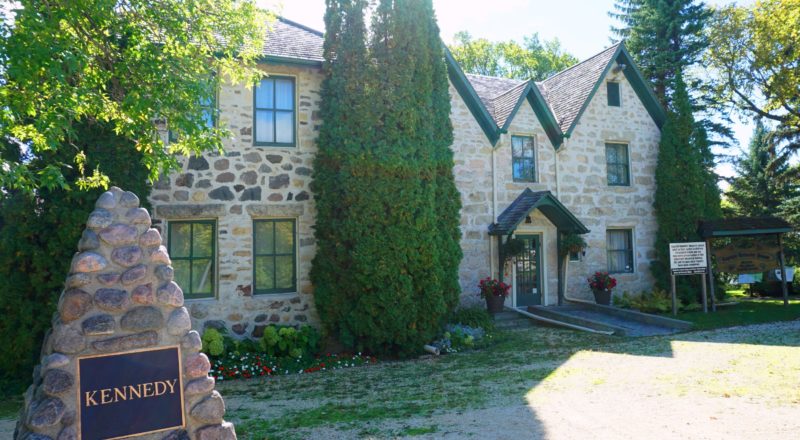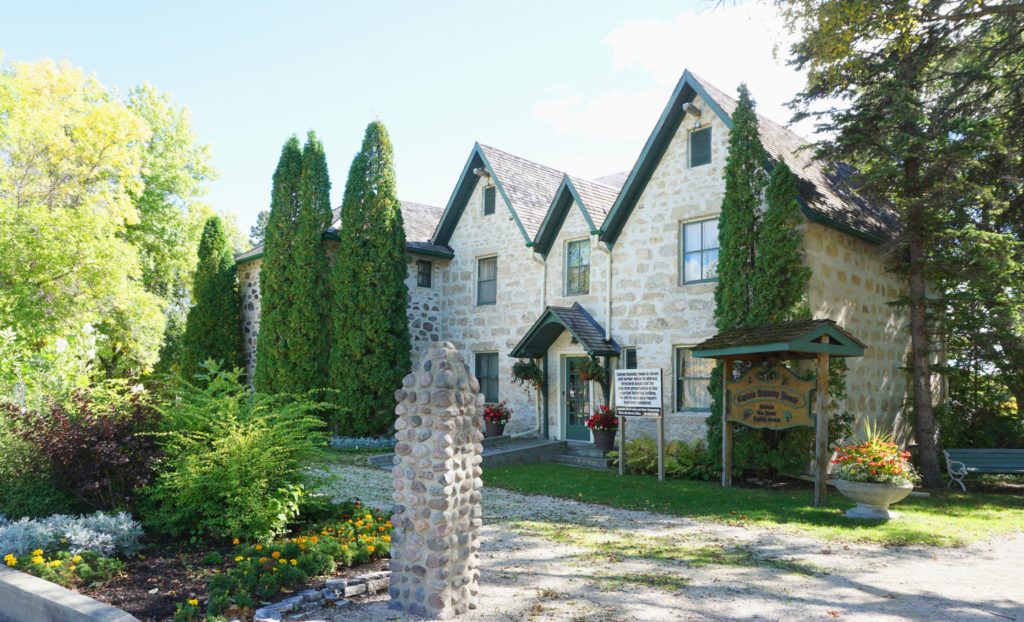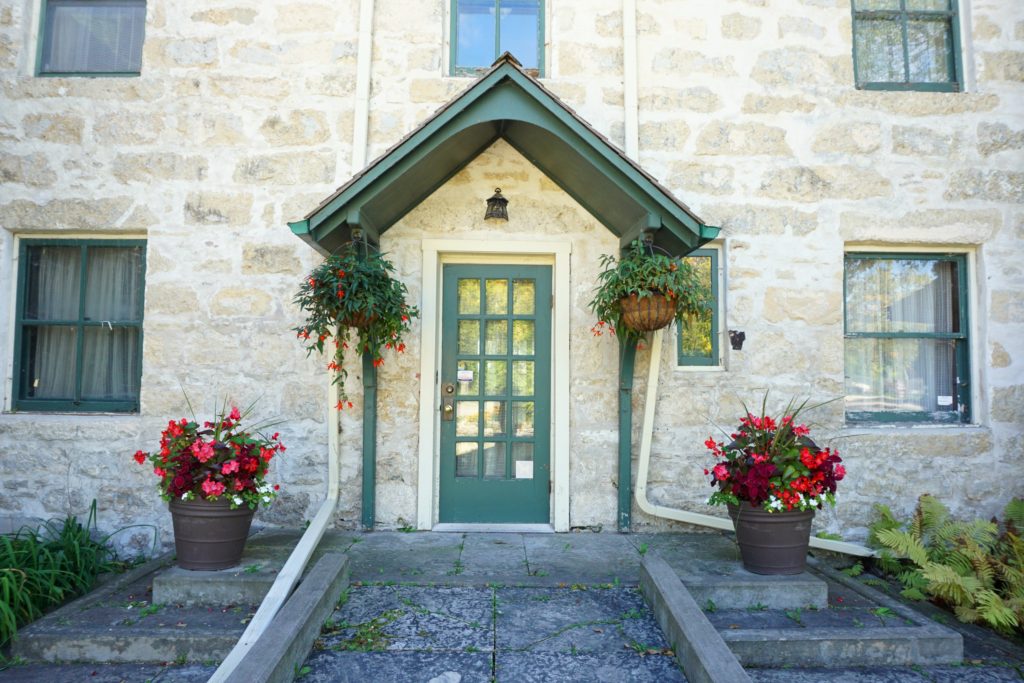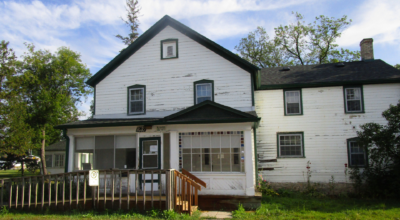
/ News
December 20, 2021
Advocacy in Action! Saving Maple Grove: The Captain William Kennedy House
Many Manitobans have taken a leisurely drive along River Road on a bright summer day, following the twists and turns of the Red River as it meanders north towards Lockport. It is along this route, on the west banks of the river, that a stately stone house, Maple Grove, has stood for over a 150 years. Often referred to as the Captain Kennedy Tea House, it is impossible to not notice this grand home from another era, with lush landscaping and glimpses of the river beyond, beckoning you to stop and explore. For decades the house was a tea room with gardens, an important tourist destination in the St. Andrews community, drawing in visitors from near and far. Erected by a respected Métis family that played an important role in Canada’s history, the house is a resilient and adaptive structure, but has faced one of the greatest threats to our community heritage: vacancy and the ensuing neglect. What will be the fate of Maple Grove?
William Kennedy was a Métis businessman, explorer and missionary from Cumberland House, Saskatchewan. Born in April 1814, Kennedy was educated in the Orkney Islands and dreamed of following in his older brothers footsteps to becoming a surgeon. After his father’s death in 1832, Kennedy did not have sufficient funds to pursue medicine and instead joined the Hudson’s Bay Company (HBC) in 1833. Kennedy’s job brought him back to Canada, where he married Sarah Stevens, an Algonquian woman, in an Indigenous ceremony. The couple had two children and a small farm on the Grand River in Ontario. After several years in eastern Canada, Kennedy would part ways with the HBC, disagreeing with their sale of alcohol to Indigenous people.
Having spent some time working in the north for the HBC, Kennedy was confident in offering his services as commander of Lady Franklin’s 1851 Arctic expedition, searching for her husband, Sir John Franklin. Always ready for adventure, Kennedy was an admirer of Sir Franklin whom he had met in Cumberland House when he was a five years old. Sir Franklin was wintering in Saskatchewan and as Kennedy’s teacher, would leave a lasting impression on the young boy. Kennedy’s search party survived the challenging trip to the north, and returned home over a year later, unsuccessful in finding Sir Franklin but overflowing with valuable groundbreaking knowledge about Arctic exploration. Some attributed the relative success of the mission to Kennedy’s refusal to bring alcohol on the voyage, but it was also likely due to his reliance on Indigenous knowledge. Lady Franklin commissioned Kennedy to search for her husband again in 1853, but mutiny ended the trip shortly after it began. Despite this, Kennedy was considered a hero for his efforts and several places in the Arctic are named after him.
“It is sad to think that when Captain Kennedy discovered and sailed through the strait between North Somerset Island and Boothin Felix – having on his left the most northern point of the continent of North America – that instead of turning south in the direction of Repulse Bay, where he would have unquestionably attained the object of his search, he was indeed, by the circumstance that Lady Franklin had attached great importance to an exploration of Cape Walker and vicinity, to take a northern source and exhaust time and efforts in a fruitless exploration of Prince of Wales Island.”
-Winnipeg Free Press, March 6, 1880, page 2
Kennedy moved back to Canada in 1856 and became a Director of the North-West Transportation, Navigation and Railway Company, and helped established mail service between Toronto and Manitoba’s Red River Settlement. He was an outspoken critic of the HBC’s rule over Rupert’s Land and lobbied for it to become a part of Canada. In London in 1859, he married the well educated upper class Englishwoman Eleanor E. Cripps, a friend and distant relative of Lady Franklin. The devoutly religious couple would soon return to Canada to spend a year as Anglican missionaries and educators in Fairford, Manitoba. Kennedy’s worsening rheumatism forced the couple to head back to England in 1862. Their return was blocked by the Sioux uprising in Minnesota, which resulted in them staying in the Red River Settlement. In 1863 Kennedy’s mother, Aggathas Bear, passed away leaving Kennedy to inherit her property, lot 63 in St. Andrew’s Parish, along with the log cabin on it. It was on this property at 417 River Road in the Rural Municipality of St. Andrews, that Kennedy would build his grand house, “Maple Grove”.
Maple Grove was constructed in 1866 by stonemason Duncan McRae, who built several notable structures in the area, including St. Andrew’s-on-the-Red Anglican Church and Old Kildonan Presbyterian Church, which still stand today. Maple Grove stood two and a half storeys tall, constructed of finely dressed fieldstone gathered from the banks of the River River at the nearby St. Andrews Rapids. Although the use of fieldstone was popular in the Settlement at the time, the style of the house, Gothic Revival, was nearly two decades ahead. The irregular and steep roofline with multiple gables would have been a major departure from the Georgian style houses in the area, but the design would have been rather plain compared to what Kennedy would have experienced in eastern Canada. Fitted with “modest yet functional details” such as high ceilings, double hung windows, carved balustrade, and mouldings, the house was a peaceful retreat on the river for the Kennedy family. It was also home to the second piano in the Settlement, where the talented Cripps would sing and play to entertain friends and family.
“I can’t help thinking of you all at Maple Grove,” wrote Emma Christie to her friend Mary Kennedy at Christmas in 1883. “I suppose you are busy preparing mincemeat puddings. Do you remember what fun we used to have over stoning the raisins, cutting up the peel and stirring the pudding? I always like to hear what hymns you sing and if you had as much fun at the decorations as we used to.“
–Manitoba Sustainable Development

Three steeply pitched gables made up the symmetrical roofline of Maple Grove’s front facade when it was first built in 1866, seen here in September 2021.
Source: Heritage Winnipeg
Kennedy would go on to run a store at Lower Fort Garry, sit on the Board of Education, become a Magistrate of Manitoba, and lobby for a railway to Churchill, Manitoba. He was also a founding member of the Manitoba Historical Society and the Winnipeg Board of Trade. Kennedy and Cripps would also petition Louis Riel to end the violence and loss of life during the Red River Resistance, becoming peacekeepers in the community during a tumultuous time. Kennedy’s efforts to convince settlers to join Canada helped ensure the province did not become part of the United States.
Though not as politically active, Kennedy’s beautiful aristocratic wife was known as “The Duchess” and was well respected, remembered for going out of her way to help those in need. In addition to having two children with Kennedy, Cripps taught music, was involved in the church, undertook charity work and perused the arts. Cripps went on to import fashion and goods, selling them from their home to support the family as Kennedy’s health declined.
Kennedy died at Maple Grove on January 25th, 1890 and was buried at the nearby St. Andrew’s-on-the-Red Anglican Cemetery. He was remembered by his daughter as generous to a fault, and as “one of our country gentlemen” by Anishinabe Chief Henry Prince. An economic depression and growing racism in a changing community would force Cripps to sell Maple Grove in 1892 to cover Kennedy’s debts. She moved with her daughter to Virden, Manitoba, where her son worked. After passing away in Virden on October 4th, 1913, Cripps was brought back to St. Andrews to be buried. Although she was disappointed with her station in life having never achieved great wealth, Cripps was remembered fondly by the community.
“The remains of the late Captain William Kennedy were laid at rest Tuesday in the parish churchyard of St. Andrews. A large number of people of the neighborhood and several from Winnipeg attended the funeral to pay their last tribute of respect to the memory of the deceased. Services were conducted at the family residence and at the church by Rev. Canon Matheson and Rev. A. L. Fortin, sand after the burial service at the gave a prayer was offered by Rev. Dr. Bryce. The pall bearers were Sheriff Inkster, Col. Bedson, Andrew Strang, George Ross, William Richards and John Leaske.”
-Winnipeg Free Press, January 30, 1890, page 6
The Reid family bought Maple Grove from Cripps, who then sold it in 1908 to John Edward McAllister, who’s wife, Caroline Norquay, was Kennedy’s neice. The McAllister’s renamed the House “Dun Allister”, Gaelic for “Home of Allister”. Maple Grove was expanded northwards in the 1920s, creating an asymmetrical facade, and a porch was added to the back in the 1950s. The roofline was changed and the internal spaces were completely rearranged over time, but everything was kept in excellent condition.
In 1968 the Maple Grove was purchased by Edward Shaw, a doctor from Winnipeg and history enthusiast, who adaptively reused the house as the Red River House Museum. Zoning bylaws and objections from neighbours would not allow the house to officially be run as a museum, but Shaw opened the fully furnished house to the public, asking for a donation instead of charging admission. The house was filled with period artifacts, some of which belonged to the Kennedy’s, including the master bedroom suite with an enormous headboard that was likely too big to have ever been removed from the room. The “modern” 1920s addition became home to Don Holbrow and family who looked after the house and museum guests. Having been a private residence until this conversion, it was Shaw who brought the historic value of the Maple Grove to the Manitoba Government’s attention. Shaw considered Kennedy’s contributions to the making of Canada invaluable, and was disappointed the Province was not more interested in celebrating that part of its history.
After Shaw’s death in 1980, Maple Grove was purchased by the Province of Manitoba, and with some restoration work taking place. This purchase was part of a larger “Master Development Plan” for the Red River Corridor, funded by a $13 million “Agreement for Recreation and Conservation” between the federal and provincial governments. But with a minimal budget, the house would never be brought back to its 19th century glory. Instead, the 1920s English gardens were recreated and interpretive plaques were placed outdoors. The 1950s porch was removed and a glass verandah was added to provide space for a tea room, called the Captain Kennedy Tea House – the name which many Manitobans associate with Maple Grove.
The first floor was furnished in the style of the late 19th century, but it was only representative, not a replica for what had once been there. The intention was for people to be able to engage with the house, sit in the chairs, read the books, to be a part of the era. But using the furnishings would mean they would wear out and need to be replaced, and there was no budget for replacements. Disappointingly, the Maple Grove became a more traditional museum with everything behind glass, but without the museum quality objects to admire. The second floor of the house was renovated as accommodations for the head gardener, who would also provided security. The house was run with enthusiasm by the Church Guild and was very popular with tourists, but was only open in the summer and failed to reach its potential due to limited resources.
In 1985 the Province of Manitoba officially recognized Maple Grove as “Manitoba Provincial Heritage Site No. 16: Captain William Kennedy House“. This acknowledged its significance to our history, but makes no provision for maintaining or protecting it.
Maple Grove became privately operated as the Maple Grove Tea Room in 2003 with an adjoining museum. It was a profitable enterprise that brought important tourism revenue into the area, attracting about 4,000 visitors every month. It hosted many weddings, family celebrations, leisurely lunches and romantic encounters, drawing in locals and international travelers alike. Along with being named one of the best places for afternoon tea in Canada in 2013 by Canadian Living Magazine, the Maple Grove was even featured in the 2014 film, Heaven is for Real.
Maple Grove was suddenly boarded up in April 2015 by the Province after a engineering report by Crozier, Kilgour & Partners indicated that the house needed structural work, including long term conservation work. A sign posted on the front of the building promised that the house would reopen once repairs were complete. The estimated cost of repairs at the time was $1 million, with a two and a half year timeline. The NDP’s 2015 provincial budget allotted funding to shore up the first and second floors, but in 2016 the newly elected Conservative government rescinded the funds. While the building had been vacant since 2015, continuing to deteriorate more with each passing year, Manitoba Conservation continued to maintain the surrounding gardens.
“The building is failing and will require significant investment to get it back to standard,” said Conservation Minister Tom Nevakshonoff. “This is a very old structure built over a hundred years ago, and it’s not an easy thing to do.”
-CBC News, September 4, 2015
In 2018 Maple Grove was deteriorating further, with the discovery of water penetrating the foundation. Red River North Tourism started a petition, calling upon the government to “release the funds necessary to do the repairs ASAP and to re-open this historic building to public use“. Over 3100 people signed the petition, but no repairs were made to Maple Grove. A second petition was started by St. Andrews Municipal Heritage Advisory Committee member Irene Foster, collecting another 300 signatures and even writing to the Queen of England to appeal for help. At the time, the government said it was “still in the process of confirming the best option(s) for reopening Capt. Kennedy House and …. contemplating other possible future options for public use and access to the building.”
The Kennedy House Renewal Committee (KHRC) recommended that the RM of St. Andrews take over the management of Maple Grove, similar to the successful local management model at the nearby St. Andrews Rectory. The RM of St. Andrews supported the plan, but it required about $200,000 from the provincial government to fix the foundation and bring the building up to code so the building could at least be reopened. Without a provincial organization to advocate for Manitoba’s built heritage, Heritage Winnipeg stepped up and joined forces with the KHRC to champion the conservation of Maple Grove. Heritage Winnipeg recognized that each day Maple Grove sat empty, the more cost prohibitive repairs would become. Time, supported by neglect, gets into everything, with the weather doing its best to help. As a result, vacant buildings all too often become demolished buildings, with their history lost forever. Maple Grove deserved to be saved from this slow demise before it was too late.
The hard work advocating for the conservation of Maple Grove has started to pay off, with a surprise announcement from the Manitoba Government on December 17th, 2021. The Government revealed it is investing $350,000 in the first phase of the Kennedy House Restoration Project, which will tackle pressing structural repairs to the foundation and first floor. The work is expected to be completed in spring 2022, potentially allowing Maple Grove to be opened to the community once again. Even more exciting is the reference to “subsequent phases of the restoration project“, giving hope that the Province is invested in supporting the long term conservation and revitalization of Maple Grove.
Today Maple Grove is a rare example of a vernacular fieldstone structure that is part of a larger collection of such buildings surviving from the Red River Settlement era. They include St. Andrew’s-on-the-Red Anglican Church, St. Andrew’s Rectory, Twin Oaks, Firth House and Scott House. Maple Grove tells the story of the affluence and respect the Métis people held prior to confederation, playing an important role in the Red River Settlement and Manitoba’s entry into confederation. It is the largest and best preserved fieldstone house along the Red River, with two others in good condition and four in poor condition. Having contributed to its community and to all who visited there for over 155 years, conserving it is the least we can do, allowing it to be filled with a vibrant heritage, arts and cultural community, celebrating its place in history!
Written by Heritage Winnipeg.
SOURCES:
417 River Road | Google Maps
About People: Dr. Edward Shaw | Maureen Schwanke, Selkirk Enterprise Newspaper – July 22, 1970, page 3
Alexander Kennedy | Province of Manitoba
Captain William Kennedy | George Siamandas, The Winnipeg Time Machine
Captain William Kennedy (1814-1890) | Red River North Heritage
Captain William Kennedy (1814-1890) | Red River Ancestry.ca
Captain William Kennedy House | Canada’s Historic Places
Cripps, Eleanor Eliza (Kennedy) | Dictionary of Canadian Biography
Eleanor Eliza Cripps Kennedy (1825-1913) | Manitoba Historical Society
A Family Journey | Sherry Dangerfield
Fate of shuttered Kennedy House drives petitions, local concern | Bill Redekop, Winnipeg Free Press – November 30, 2018
The Heritage of the River Road Manitoba | Jean Friesen, Society for the Study of Architecture in Canada Bulletin – Volume 12, Issue 3, 1987
House full of history | Winnipeg Free Press – August 30, 1996, page 38
Kennedy House | The Canadian Encyclopedia
Kennedy House (417 River Road, RM of St. Andrews) | Manitoba Historical Society
Kennedy House tea room faces 2.5 year closure: province | CBC News – September 4, 2015
Kennedy, William | Dictionary of Canadian Biography
Local committee has plans to save the historic Kennedy House | Pegasus Publications
Manitoba Provincial Heritage Site No. 16 | Government of Manitoba
Manitoba Government Invests $350,000 to Support Restoration and Preservation of Captain Kennedy Heritage House | Province of Manitoba – December 17, 2021
The Race for the Pole | Winnipeg Free Press, March 6, 1880, page 2
Maple Grove Tea Room | Valerie Brown
Red River House | Sheila Bleeks, Winnipeg Free Press – January 4, 1969, page 71
Red River House Museum St. Andrews | Elsie McKay, Selkirk Enterprise – July 5, 1972, page 6
River Road Provincial Heritage Park: Kennedy House | Manitoba Sustainable Development
St. Andrews group calling on government to fix historic building | Mike Arsenault, CTV News – April 25, 2021
Save Captain Kennedy House | Change.org
Sir John Franklin | Canadian Encyclopedia
A Shortage of Something Sad, A Spot of Manitoba History and Saying Hello | MaryLou Driedger, What Next?
Tea with the Captain is Long Overdue | Red River North Tourism Association
A Trip through history along River Road | Val Werier, Winnipeg Free Press – August 17, 1985, page 6
William Kennedy (1814-1890) | Manitoba Historical Society
Updates:
February 8th, 2024: “Progress at Kennedy House! Phase II Commences”















